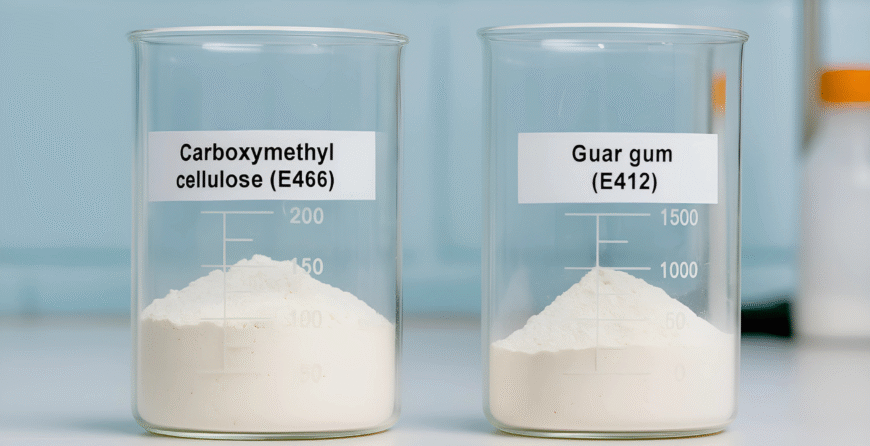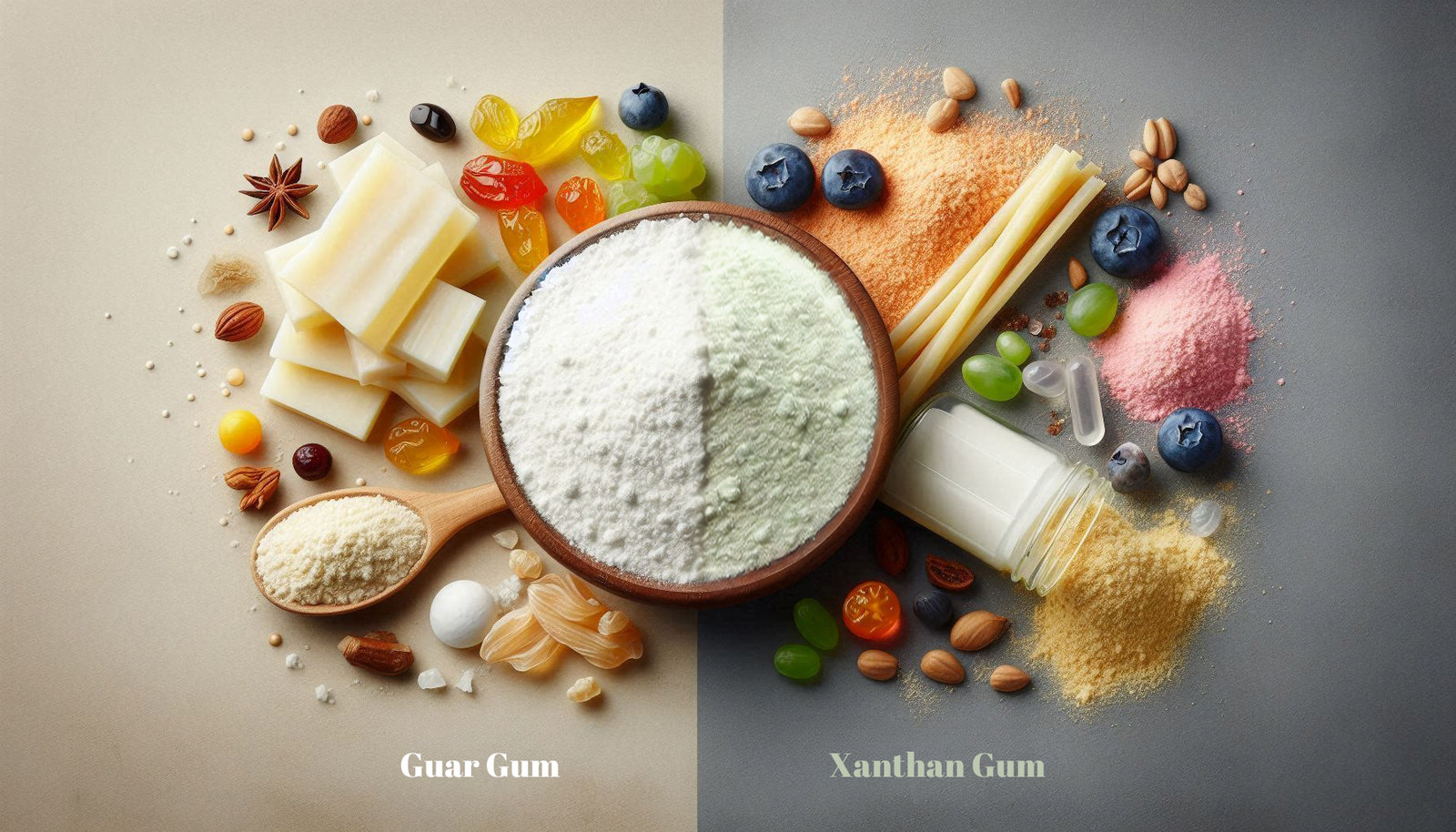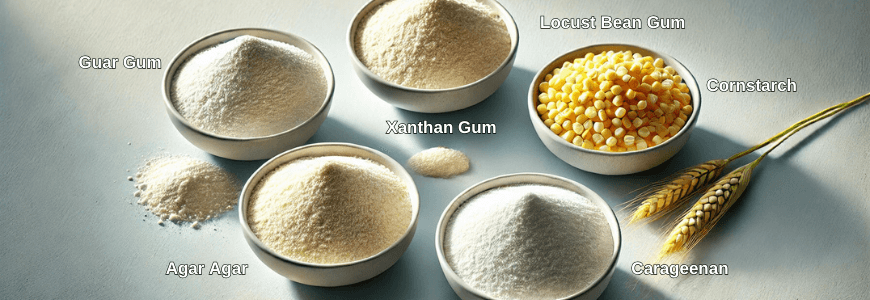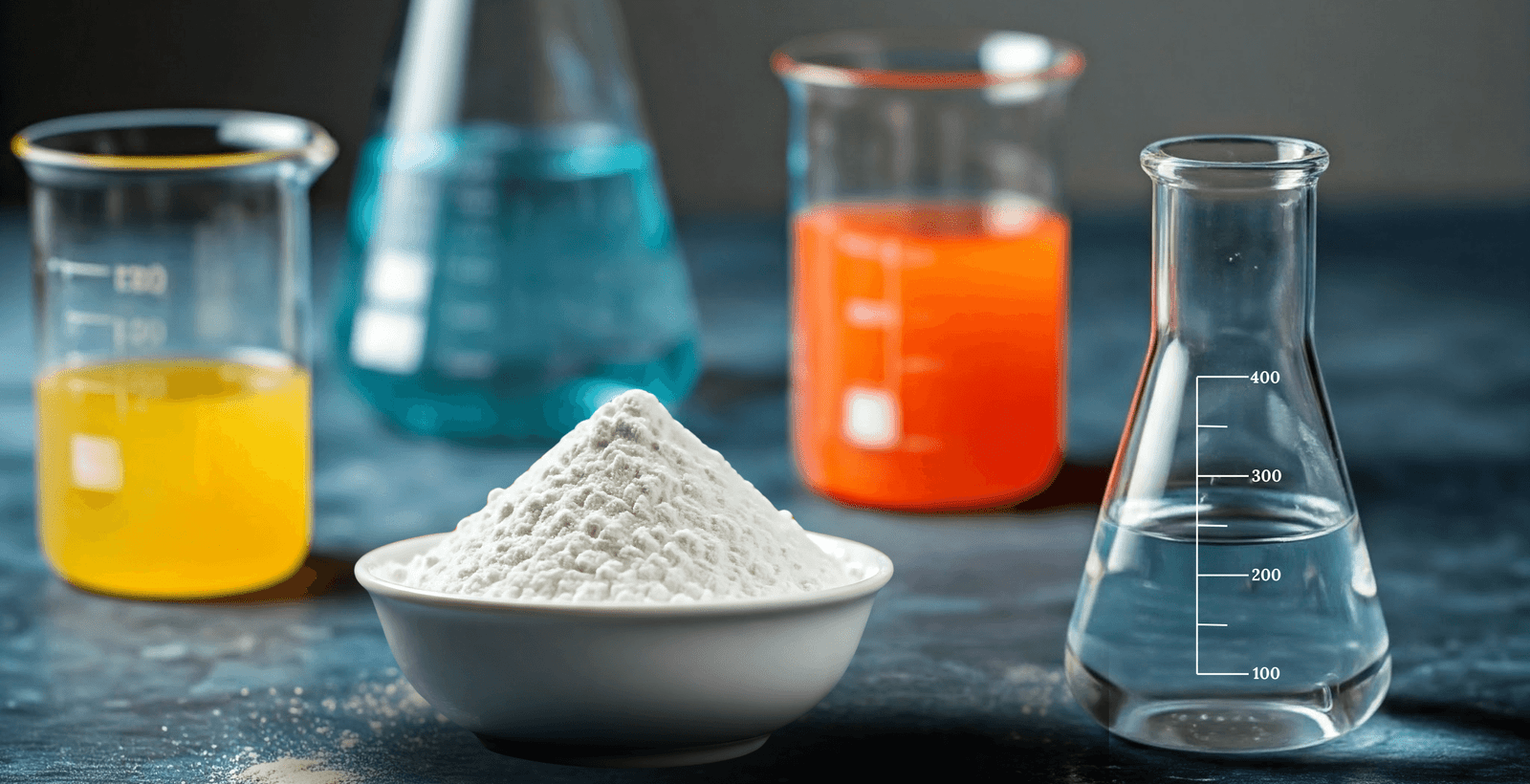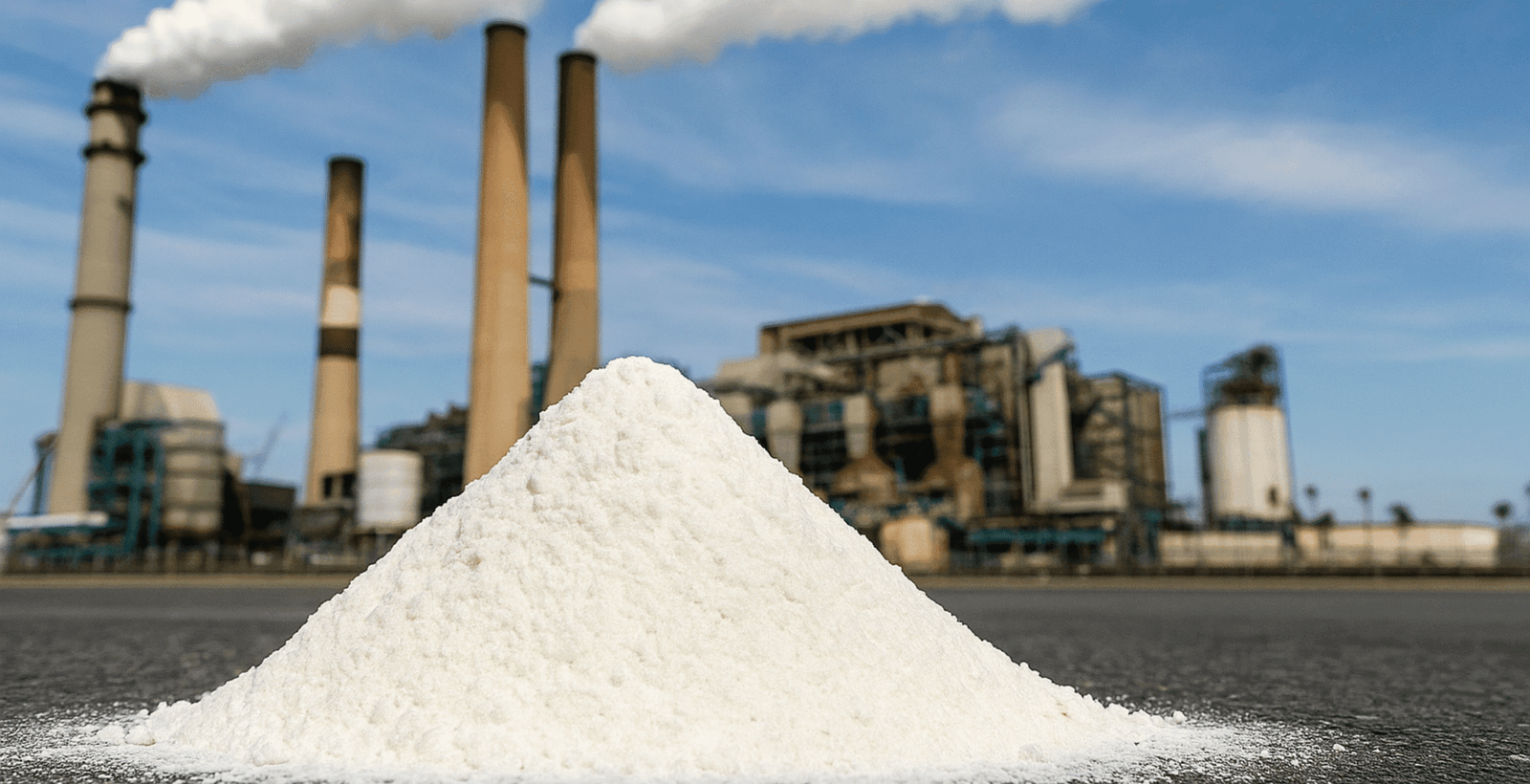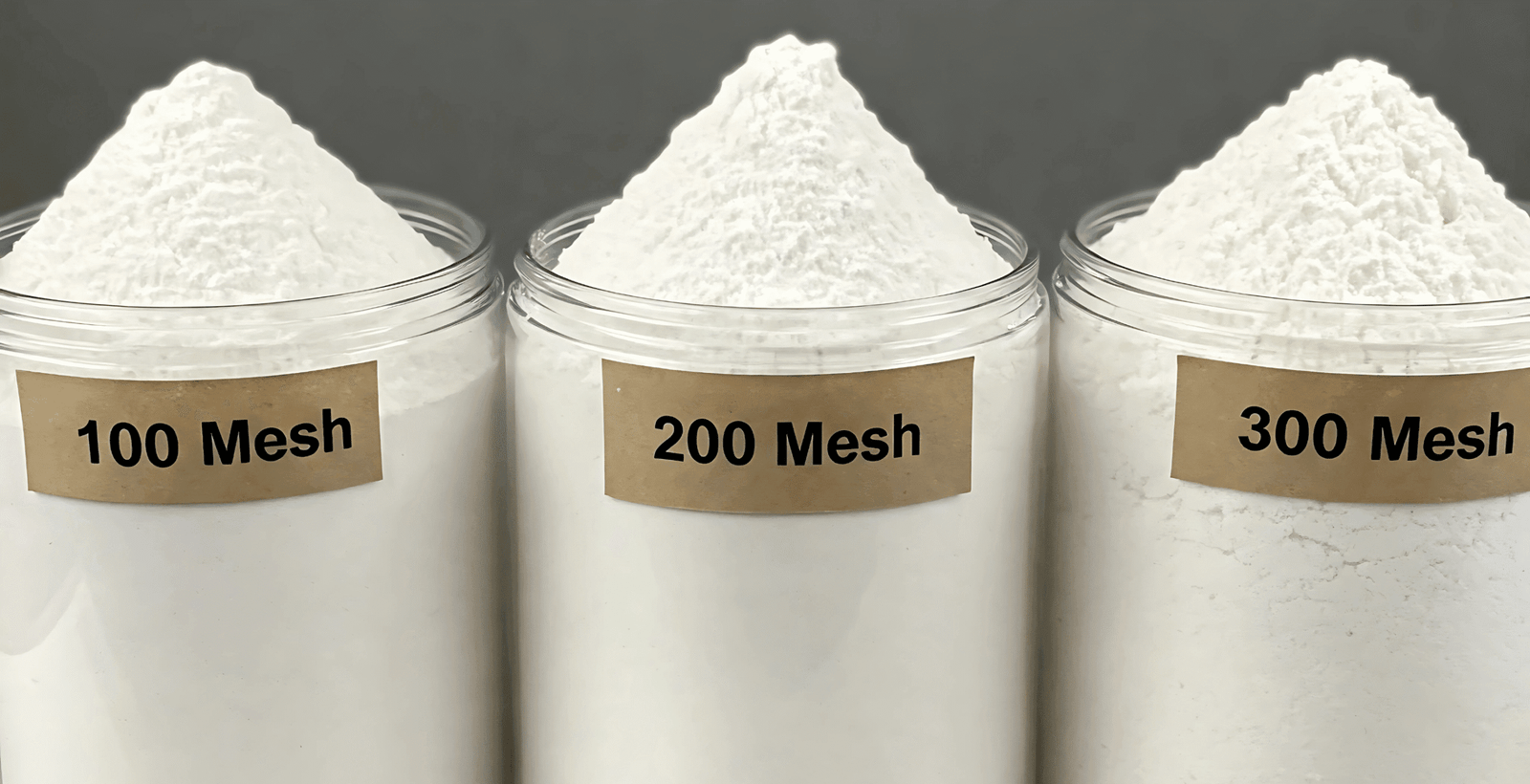In the world of thickeners, stabilizers, and emulsifiers, several names often come up, and many people get confused about their differences. Two commonly compared ingredients are CMC (Carboxymethyl Cellulose) and Guar Gum. Both are widely used across the food, chemical, and industrial sectors, yet they differ significantly in their source, properties, applications, and performance. Understanding CMC vs Guar Gum is essential for manufacturers and formulators seeking optimal results in their products.
What is CMC?
CMC gum, or Carboxymethyl Cellulose, is a semi-synthetic derivative of cellulose, a natural polymer obtained from wood pulp or cotton fibers. It is synthesized through a chemical process involving alkalinization and etherification, resulting in a water-soluble polymer that provides medium viscosity, stabilizing properties, and resistance to heat, acids, and salts. Its food additive code is E466, and it finds extensive use as a thickener, stabilizer, and emulsifier.
SYNONYMS: Sodium cellulose glycolate; Na CMC; cellulose gum; sodium CMC; INS 466, E466
What is Guar Gum?
Guar Gum is a natural polysaccharide extracted from the inner part of guar beans. Known for its high viscosity at low dosage, it is fully biodegradable and eco-friendly. In the food industry, it is referred to as E412 and is widely used for thickening sauces, dressings, bakery products, beverages, and gluten-free foods. In industrial applications, Guar Gum is popular in oil drilling, mining, textiles, and paper for its strong thickening and binding capabilities.
SYNONYMS: Guaran, Guarkernmehl, Guar gum [NF], Cyamopsis tetragonoloba, INS 412, E412
CMC vs Guar Gum: Major Comparison:
When comparing CMC vs Guar Gum, it is important to know the key differences between them, such as:
1. Source and Naturalness:
CMC and Guar Gum differ primarily in origin. Sodium carboxymethylcellulose is not natural, it is synthesized by alkalinization and etherification, although the raw material cellulose comes from natural sources, while Guar Gum is completely natural, biodegradable,extracted directly from guar beans, 100% plant-based, and fits “natural / clean label” claims. For companies targeting clean-label products, Guar Gum has a significant advantage due to its natural origin.
2. Viscosity and Dosage:
CMC and Guar Gum Viscosity plays a crucial role in choosing a thickener. Guar Gum provides high viscosity at very low dosage (0.2–0.5%), making it ideal for applications where strong thickening is required without adding excessive material. In guar, solution may start thick at a very low dose, but if heated for long or mixed with strong chemicals, it can become thinner. In contrast, CMC provides moderate viscosity at medium dosage (0.5–1.5%), but it is highly stable under chemical and thermal stress. This difference makes CMC preferred in formulations requiring long-term stability.
3. Stability:
One of the key differences in CMC vs Guar Gum is stability. CMC maintains its viscosity under heat, acids, alkalis, and saline conditions, making it suitable for industrial applications like paints, detergents, and chemical formulations. Guar Gum, while offering higher viscosity, is less stable in harsh chemical or high-temperature environments, which limits its use in certain industrial processes.
4. Cost-Effectiveness:
Cost is an important consideration. Guar Gum is more cost-effective because a small amount produces high viscosity. It is abundant and naturally derived, making it ideal for bulk applications such as oil drilling and food thickening. It is also drought-tolerant, which means it requires less water for cultivation. CMC, on the other hand, is more expensive due to its chemical synthesis and higher dosage requirements, but it offers performance advantages in demanding environments. CMC can be cost-effective in the long run in detergents, paints, or saline drilling fluids where stability is critical (because guar would break down and fail with strong chemicals).
TLDR; CMC vs Guar Gum:
Followed By Applications: CMC vs Guar Gum:
CMC vs Guar Gum’ s Applications in Food Industry:
CMC and Guar Gum both play significant roles in food, but their applications vary. while talking about CMC vs Guar Gum, CMC is used in ice creams, baked goods, sauces, soups, and beverages as a stabilizer, emulsifier, and fat replacer. It helps prevent ice crystallization in frozen desserts and improves dough consistency in bakery items.
Guar Gum excels in gluten-free bakery, sauces, dressings, and beverages, providing body, texture, and moisture retention along with clean label foods. Its natural origin makes it a preferred choice for clean-label and health-focused products.
Comparison in Food: CMC vs Guar Gum:
CMC vs Guar Gum – Applications in Industrial and Chemical Sectors:
In industrial use, Guar Gum is widely used in oil drilling, hydraulic fracturing, mining, paper, and textiles due to its high viscosity at low dosage. It effectively suspends solids, controls water loss, and improves binding.
CMC finds its niche in detergents, paints, adhesives, paper coating, and textile printing, where stability under heat, acids, salts, and long-term storage is critical. Its moderate viscosity and chemical resistance make it ideal for demanding formulations.
These distinctions become particularly useful when assessing CMC vs Guar Gum, as each polymer offers unique strengths depending on the application.
Substitute for Guar Gum:
For formulators looking for alternatives, CMC can serve as a substitute for guar gum in certain applications, especially where stability is more critical than high viscosity. However, in applications requiring natural ingredients and very high thickening at low dosage, Guar Gum remains the preferred choice.
CMC vs Guar Gum Applications in Industrial and Chemical Sectors:
In industrial use, Guar Gum is widely used in oil drilling, hydraulic fracturing, mining, paper, and textiles due to its high viscosity at low dosage. It effectively suspends solids, controls water loss, and improves binding.
CMC finds its niche in detergents, paints, adhesives, paper coating, and textile printing, where stability under heat, acids, salts, and long-term storage is critical. Its moderate viscosity and chemical resistance make it ideal for demanding formulations.
Comparisons with Other Thickeners:
1. CMC vs Tylose Powder: Tylo/Tylose Powder and CMC (Carboxymethycellulose) are essentially the same thing, with a slight difference in naming. Tylo/Tylose powder are more brand names, and CMC is their main ingredient. CMC refers to the chemical compound itself, widely used as a thickener, stabilizer, and binder across food, pharmaceutical, and industrial applications. On the other hand, Tylo or Tylose Powder are brand names or commercial forms of CMC, often marketed for specific uses.
2. CMC vs Xanthan Gum: Xanthan Gum is a microbial polysaccharide offering high viscosity at low concentrations, similar to Guar Gum. Compared to xanthan gum, CMC is more chemically stable, especially in acidic or saline conditions, but again provides moderate viscosity.
Key Considerations When Choosing Between CMC vs Guar Gum:
1. Viscosity Requirements: Choose Guar Gum for very high viscosity at low dosage; choose CMC for moderate viscosity with stable performance.
2. Chemical & Thermal Stability: CMC is ideal for harsh chemical environments; Guar Gum works best in mild conditions.
3. Cost: Guar Gum is more cost-effective in bulk applications; CMC is more expensive but justified in demanding formulations.
4. Food vs Industrial Use: Guar Gum dominates in natural, clean-label foods; CMC excels in processed foods, paints, detergents, and adhesives.
5. Regulatory / Labeling Considerations: Guar Gum is natural (E412), appealing for health-conscious consumers; CMC is semi-synthetic (E466), suitable where clean-label is not critical.
After comparing CMC vs Guar Gum, how to choose between them:
The choice between E466 and E412 depends on the specific application and desired properties:
1. For cost-effectiveness: Guar gum (E412) is often considered one of the most economical thickening agents.
2. For powerful thickening: Guar gum (E412) is an extremely efficient thickener, providing high viscosity at low concentrations.
3. For gluten-free baking: Guar gum (E412) is frequently used to provide the structure and elasticity that gluten would normally offer.
4. For moisture retention: Both E466 and E412 are effective, but E466 is explicitly used to improve moisture retention in baked goods, while E412 helps baked goods stay soft.
5. For specific food pairings: E466 works well in soy milk to prevent fat from floating and protein from settling. Guar gum is often used to prevent ice crystal formation in ice cream.
6. For natural vs. modified ingredients: E412 is a naturally derived product from guar beans, while E466 is a semi-synthetic, chemically modified cellulose.
Conclusion:
Knowing in-depth about CMC vs Guar Gum is essential for manufacturers, food scientists, and formulators. While Guar Gum provides high viscosity, natural origin, and cost-effectiveness, CMC offers moderate viscosity, chemical stability, and suitability for industrial applications. The choice depends on the application, desired properties, cost considerations, and consumer preferences.
Whether working on food, beverages, industrial chemicals, or oil drilling, knowing the differences between CMC and Guar Gum allows you to make informed decisions that optimize product performance, cost, and quality.
By considering factors like viscosity, stability, naturalness, and dosage, manufacturers can choose the right thickener for their specific needs, whether it’s substitute for guar gum (CMC vs Guar Gum), CMC vs Tylose powder, or CMC vs Xanthan Gum.
Frequently Asked Questions (FAQs):
1. What is the main difference while talking about CMC vs Guar Gum?
The main difference lies in their origin: CMC (E466) is a semi-synthetic derivative of cellulose, while Guar Gum (E412) is a natural, plant-based thickener derived from guar beans.
2. Is Guar Gum natural or synthetic?
Guar Gum is 100% natural, biodegradable, and plant-based, making it a popular choice for clean-label and health-focused products.
3. Is CMC safe to eat?
Yes, Carboxymethyl Cellulose (CMC) is approved as a safe food additive by the FDA, EFSA, and JECFA, with an acceptable daily intake (ADI) considered safe under normal usage levels.
4. Is Guar Gum safe to eat?
Yes, Guar Gum is approved by regulatory bodies like the FDA, EFSA, and JECFA as a safe food additive. Its ADI (Acceptable Daily Intake) is “not specified,” meaning it is safe at levels needed for food applications.
5. CMC vs Guar Gum: which thickener provides higher viscosity?
Guar Gum provides much higher viscosity at a very low dosage (0.2–0.5%), while CMC provides moderate viscosity but is more stable in acidic, salty, or high-temperature conditions.
6. Can CMC be used as a substitute for Guar Gum?
Yes, in certain formulations where stability under heat, acid, or saline conditions is more important than very high viscosity, CMC can be a substitute for Guar Gum.
7. Why is Guar Gum considered more sustainable?
Guar Gum is plant-based, renewable, biodegradable, and supports agricultural economies (especially in India). Its production has a lower environmental impact compared to the chemical synthesis of CMC.
8. Which is more cost-effective: CMC or Guar Gum?
Guar Gum is generally more cost-effective due to its high viscosity at low dosages and natural abundance. CMC tends to be more expensive but offers advantages in demanding industrial formulations.
9. What industries use CMC the most?
CMC is widely used in detergents, paints, adhesives, paper coatings, and textile printing, thanks to its chemical and thermal stability.
10. What industries use Guar Gum the most?
Guar Gum is heavily used in food products, oil drilling, mining, paper, textiles, and pharmaceuticals, especially where high viscosity and natural labeling are important.
11. How does consumer perception differ between CMC vs Guar Gum?
Consumers often view Guar Gum (E412) as natural and clean-label, while CMC (E466) is seen as a synthetic additive, even though both are safe.
12. Which is better for gluten-free baking: CMC or Guar Gum?
Guar Gum is generally preferred in gluten-free bakery because it provides elasticity, moisture retention, and texture naturally, while CMC is more common in processed foods.

